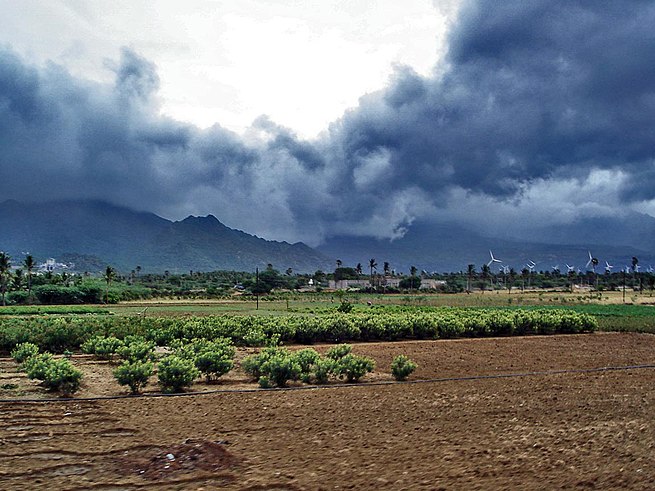
Main Difference
The main difference between Monsoon and Cyclone is that the Monsoon is a seasonal changes in atmospheric circulation and precipitation associated with the asymmetric heating of land and sea and Cyclone is a large scale air mass that rotates around a strong center of low pressure
-
Monsoon
Monsoon () is traditionally defined as a seasonal reversing wind accompanied by corresponding changes in precipitation, but is now used to describe seasonal changes in atmospheric circulation and precipitation associated with the asymmetric heating of land and sea. Usually, the term monsoon is used to refer to the rainy phase of a seasonally changing pattern, although technically there is also a dry phase. The term is sometimes incorrectly used for locally heavy but short-term rains, although these rains meet the dictionary definition of monsoon.The major monsoon systems of the world consist of the West African and Asia-Australian monsoons. The inclusion of the North and South American monsoons with incomplete wind reversal has been debated.The term was first used in English in British India and neighbouring countries to refer to the big seasonal winds blowing from the Bay of Bengal and Arabian Sea in the southwest bringing heavy rainfall to the area.
-
Cyclone
In meteorology, a cyclone is a large scale air mass that rotates around a strong center of low atmospheric pressure. Cyclones are characterized by inward spiraling winds that rotate about a zone of low pressure. The largest low-pressure systems are polar vortices and extratropical cyclones of the largest scale (the synoptic scale). Warm-core cyclones such as tropical cyclones and subtropical cyclones also lie within the synoptic scale. Mesocyclones, tornadoes and dust devils lie within smaller mesoscale. Upper level cyclones can exist without the presence of a surface low, and can pinch off from the base of the tropical upper tropospheric trough during the summer months in the Northern Hemisphere. Cyclones have also been seen on extraterrestrial planets, such as Mars and Neptune. Cyclogenesis is the process of cyclone formation and intensification. Extratropical cyclones begin as waves in large regions of enhanced mid-latitude temperature contrasts called baroclinic zones. These zones contract and form weather fronts as the cyclonic circulation closes and intensifies. Later in their life cycle, extratropical cyclones occlude as cold air masses undercut the warmer air and become cold core systems. A cyclone’s track is guided over the course of its 2 to 6 day life cycle by the steering flow of the subtropical jet stream.
Weather fronts mark the boundary between two masses of air of different temperature, humidity, and densities, and are associated with the most prominent meteorological phenomena. Strong cold fronts typically feature narrow bands of thunderstorms and severe weather, and may on occasion be preceded by squall lines or dry lines. Such fronts form west of the circulation center and generally move from west to east; warm fronts form east of the cyclone center and are usually preceded by stratiform precipitation and fog. Warm fronts move poleward ahead of the cyclone path. Occluded fronts form late in the cyclone life cycle near the center of the cyclone and often wrap around the storm center.
Tropical cyclogenesis describes the process of development of tropical cyclones. Tropical cyclones form due to latent heat driven by significant thunderstorm activity, and are warm core. Cyclones can transition between extratropical, subtropical, and tropical phases. Mesocyclones form as warm core cyclones over land, and can lead to tornado formation. Waterspouts can also form from mesocyclones, but more often develop from environments of high instability and low vertical wind shear. In the Atlantic and the northeastern Pacific oceans, a tropical cyclone is generally referred to as a hurricane (from the name of the ancient Central American deity of wind, Huracan), in the Indian and south Pacific oceans it is called a cyclone, and in the northwestern Pacific it is called a typhoon.
The growth of instability in the vortices is not universal. For example, the size, intensity, moist-convection, surface evaporation, the value of potential temperature at each potential height can affect the nonlinear evolution of a vortex.
-
Monsoon (noun)
Any of a number of winds associated with regions where most rain falls during a particular season.
-
Monsoon (noun)
Tropical rainy season when the rain lasts for several months with few interruptions.
-
Monsoon (noun)
The rains themselves.
-
Monsoon (noun)
Entire meteorological systems with such characteristics.
-
Cyclone (noun)
A system of winds rotating around a center of low atmospheric pressure.
-
Cyclone (noun)
A low pressure system.
-
Cyclone (noun)
The more or less violent, small-scale circulations such as tornadoes, waterspouts, and dust devils.
-
Cyclone (noun)
A strong wind.
-
Cyclone (noun)
A South Pacific and Indian Ocean weather phenomenon that results in wind speeds of around 150 to 200 km/h.
-
Cyclone (noun)
A cyclone separator; the cylindrical vortex tube within such a separator
-
Cyclone (noun)
a system of winds rotating inwards to an area of low barometric pressure, with an anticlockwise (northern hemisphere) or clockwise (southern hemisphere) circulation; a depression.
-
Cyclone (noun)
another term for tropical storm
